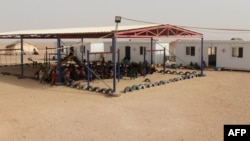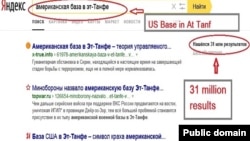On November 27, Russia called for “excluding Syria’s Rukban refugee camp, located near the U.S. base in al-Tanf, Syria, from the zone controlled by the United States.”
The proposal came the same day the Russian Defense Ministry accused the United States of creating an “unprecedented” humanitarian crisis in the Rukban refugee camp, which is located near the coalition military base in al-Tanf.
This is not the first time the Russian state and military officials voiced such allegations, in fact, similar statements have been made regularly since the establishment of the coalition military base in al-Tanf in April 2017.
Al-Tanf is a place in southern Syria, where the borders of Jordan, Syria and Iraq meet. Last July, the area was declared a deconfliction zone, under an agreement between the U.S. and Russia.
The Rukban refugee camp to which the Russian Defense Ministry refers, also known as the Berm, is located about six miles from Al-Tanf.
Polygraph.info obtained from a trusted source a detailed “Inter-agency Operational Plan for delivery of a humanitarian aid to Rukban camp,” which was developed earlier this month by the United Nations, Red Cross, World Health Organization and other actors.
According to the document, the Rukban crisis did not start after the U.S.-led coalition established a military base, but has been ongoing since the spontaneous formation of the camp in 2014, after Jordan enforced “stricter admission management into its territory.”
The Jordanian authorities closed their border in June 2016 after an Islamic State suicide attack that killed and injured several Jordanian border guards.
Large numbers of refugees who were hoping to cross into Jordan instead ended up in the Rukban camp. The document states that, as of October 2017, “between 30,000 and 55,000 people --70 to 80 per cent of whom are estimated to be women and children - are living in the camp under very difficult conditions and without access to basic services.”
According to the document, the delivery of humanitarian aid to a distribution warehouse near the Rukban camp “requires a safe passage guarantee by the governments of Syria, the Russian Federation, the United States and Jordan.”
This contradicts Russia’s claims that the U.S. is solely responsible for the crisis, and shows that the cooperation of all parties is necessary for the aid plan to work.
“Russian and pro-regime media are spreading disinformation in order make their siege of the camp look like a U.S. effort to block aid deliveries to the camp,” says Matti Suomenaro, a Syria researcher fo the Institute for the Study of War in Washington, DC, who says the main U.S. partner in the areas is Maghawir al Thowra (MaT), which is “actively trying to protect aid deliveries” to Rukban and has fighters stationed inside the camp to face off the Islamic State.
The press desk of the Combined Joint Task Force (CJTF)-Operation Inherent Resolve, which is the joint task force established by the U.S.-led international coalition against the Islamic State, told Polygraph.info via email: “Throughout the conflict in Syria, the Coalition has provided extensive operational support to U.N. agencies operating in Rukban. The Coalition has repeatedly advised the Russians over the past several months that the Coalition is prepared and poised to help facilitate the movement of humanitarian aid to Rukban, but the Syrian regime has consistently, intentionally prevented those efforts.”
Russia’s accusations regarding Rukban camp are “absurd” and “completely false,” the CJTF-Operation Inherent Resolve press desk said, adding that “the Coalition is comprised of 70 nations and four non-state organizations, with no one country in charge.”
The Russian Defense Ministry’s claims “are factually incorrect,” said Martin Reardon, vice president of the Soufan Group, a think tank specializing in terrorism analysis, in an email from Doha.
“The deconfliction zone around al-Tanf was established by the U.S. last summer, with Russian concurrence, as a limiting measure to reduce the likelihood of direct contact between U.S. and Syrian regime/Iranian forces,” Reardon noted.
The deconfliction zone “has not been a hindrance to humanitarian relief efforts,” he said.
According to Reardon, “To suggest that loyalist forces (forces loyal to Syrian president Bashar Assad) are making any attempt at providing humanitarian relief there is unfounded.”
Both the Central Command press office and Martin Reardon called Russia’s allegations “state-generated propaganda aimed at undermining the U.S.”
“Russia and its ground partners want to retake this territory so it makes sense that they would try to make these claims to undermine the U.S. presence,” says Suomenaro. “Al Tanf is the only non-regime controlled section of the Syrian-Iraqi-Jordanian border south of the Euphrates River.”
An analysis of Russian media suggests Reardon’s assessment is correct.
As shown on this screenshot from the Russian Internet search engine Yandex.ru, a search for “American base in Al Tanf” yielded 31 million results during a seven-month period, which is a strong indication of an organized media campaign. The headlines vary from “The Americans use civilian refugees as a shield,” to “American base in Al Tanf is a territory of controlled terrorism,” to “U.S. base in Al Tanf is a symbol of the collapse of the American lies about fighting terrorism in Syria.”
“We recommend that the Russian Defense Ministry focuses less energy on disseminating propaganda, and more effort on convincing the Syrian regime to allow delivery of much-needed supplies to Rukban,” the CJTF-Operation Inherent Resolve Press Desk said.







